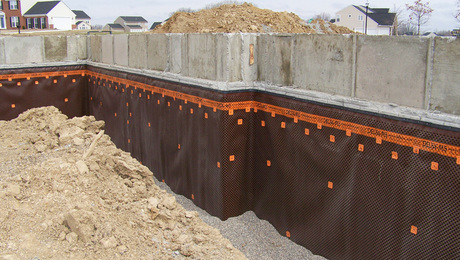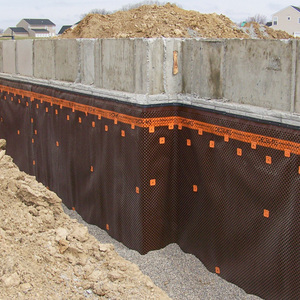Here I go again, working with someone who views many things differently than I do. He wants to patch cracks (that are leaking) in a concrete block basement wiith hydraulic cement. I agree that it is what to use on large cracks, small holes or areas where I can widen the bottoms of the cracks or holes so the cement “keys” in. But he wants me to spread a coat over the surface to fix “pinholes”.
Since hydraulic cement expands as it cures, I tried to tell him it will not work for that. It will pop itself off of the surface as it cures. The areas he has already done this way are still adhered, but when I tap on them with a trowel, they are hollow, and if they are cracked, I can easily flake the cement off in big chunks.
I think specially formulated patching cement that is latex modified for use as topping and can be feathered is the way to go. On one large spalled area I went ahead and used some patching cement I had–mix a slurry and work that in first, then make the mix a little stiffer and finish it with that. I did the same thing on a sloped window ledge that had “punky” areas I dug out, but couldn’t form a real “key”. (The guy left me alone to work, so I did it my way, but today he will be there and expects me to use hydraulic cement to top coat and fill hairline cracks and larger cracks and holes, especially where the walls meet the floor (he is supply a drywall corner knife–I didn’t want to ruin mine!)
Since I will also be painting the walls (and onto the floor at the edge) with Dry-lok, I don’t really want all the patching to flake off on two weeks so I can do it again. I hate Dry-lok–I think he just rolls it on, but I work it in with a brush, otherwise, surprise, it just flakes off. I don’t mind work, I just hate work that has no effect!
Any ideas? Will hydraulic cement work as a surface finish?



















Replies
I have seen hydraulic cement do just as you describe - hollow, flake off. I can't imagine it will work well with Drylok on top.
I'm assuming you've told him that the only way to really waterproof the block is from the other side? Good luck with this one.
Well, I did point out the holes in outside and I will plug those, but digging up whole foundation is out of question--I think he does know it is only way to waterproof because we did it in another house where we had to dig out to put in egress windows (but then he waited till I had dug hole for window and put in the gravel, then said, "Oh, we'd better dig the hole to the corner so I can get to where the leak is." So I used shovels and boards and landscape fabric to hold back the gravel some and dug another three feet over. Loads o fun!).
Yikes, he sounds like a winner.
You left out a critical detail: Who ends up paying when his harebrained ideas don't work? If it's his nickle, and you're not too worried about him bad-mouthing you later, then tell him clearly once then go ahead and do it his way.
It was settled his way later today. I actually used some patching cement on parts and told him and explained why and that I wanted to use same on other parts that were not holes or cracks where expanding hydraulic cement could "get a grip". He was okay with some of it, but at the end, when I kept having to go get more, he made me get hydraulic cement (somehow he thought that a one gallon can of dry cement would do all the holes and cracks, plus he wanted a fillet around the entire perimeter of the wall--about 100-120 lineal feet--I ended up using four or five gallons). So I used two containers of vinyl modified patching cement and two containers of hydraulic. We'll see which holds up. I get to paint the walls with oil-based Dry-Lok tomorrow! Yippeee.
He wins every argument--he got the job, he has the license; if the HO isn't satisfied, they'll talk to him, not me. I'm just the sub. I just try to keep him from doing what I consiuder to be stupid things.
The darned hydraulic cement sets so quickly, I barely had enough time after mixing a cup of it to get it in place before it was hard. So Marc suggested just pouring the dry powder along the wall at the floor and spraying water on it and working it that way. So I did that sort of--used a pale of water and a 5" paintbrush to fling water onto the cement powder and mix it and trowel it all at same time. Worked okay, but my wrists and back and legs are sore (also helped him remove siding from one side of house and I cleaned out all the gutters--got about two bushel baskets of nasty, stinking leaves, muck and twigs out of the gutters).
For the fillet type thing I've in the past used thinset. It has excellent adhesion properties and forms up nicely.
What is wanted is not the will to believe, but the will to find out, which is the exact opposite. --Bertrand Russell
Marc had some thinset sitting down there--long story, but the lady who hired me to put in a plastic tub surround (she talked about tile and I said I'd do that, but then she decided to go with plastic) had Marc tear that out two years later and so the thinset was sitting in basement from that (he just did it just this spring). (I tried to talk the lady into using Marc because he is licensed and insured and I am not and really shouldn't be doing what I did--put in replacement (insert-style) windows, new vanity and toilet, vinyl fooring in bath, painted old aluminum siding (which Marc is right now tearing off and replacing with vinyl and will be replacing fully some of the windows--not sure if any are the ones I did.
[It all started with me fixing her stairs to basement sort of as a favor since I went to same church. The basement stair stringers were pulling away from each other and the treads were just hanging from nails--very unsafe. So I pulled everything together with threaded rods and glued and nailed on cleats to hold treads (as well as angle irons) and added nosing to make the steps deeper, etc. Then she wanted the living and dining rooms painted, but wanted walls green and ceilings white where the wall/ceiling junction was a cove. So I put up a molding to delineate the transition. I've talked about that here before and posted pictures. Then she talked me into the other work.]
Marc had me use thinset to patch holes and cracks in her driveway last year (on the hottest day of the year!). (We were there to rip out old driveway extension and put in pavers.) I didn't think thinset would work at all for that, and I was right--it has now re-cracked, pulverized and lots of it has fallen out of the cracks. Now, that would be a problem with any hard patch because the driveway is moving and the cracks are opening, but vinyl concrete patch and the pourable flexible filler is what I would have used there.